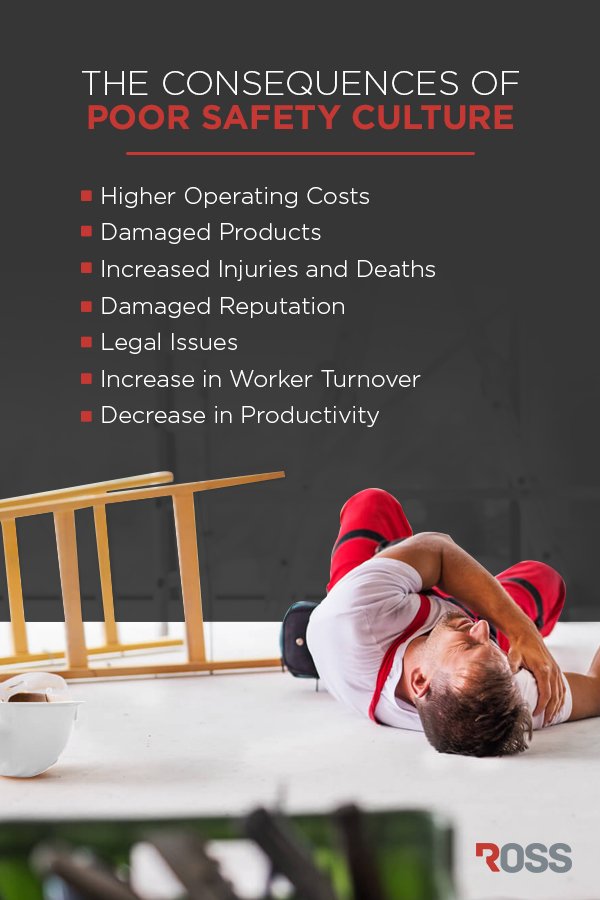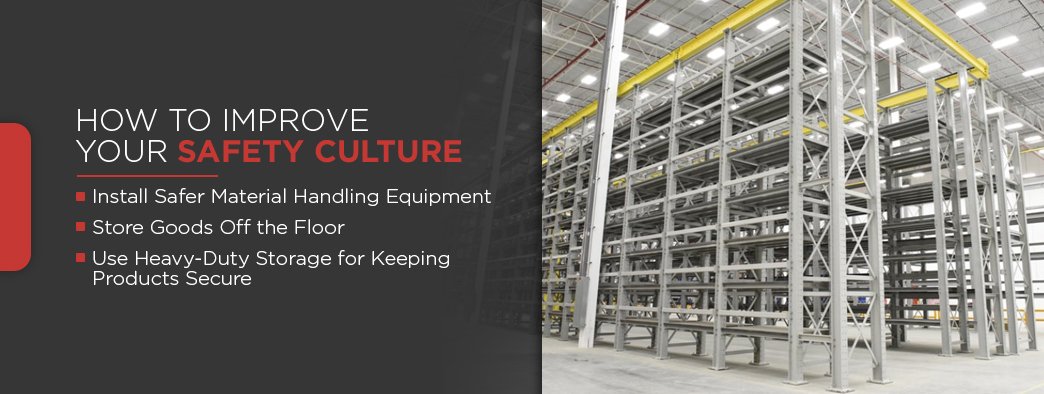Establishing a positive safety culture should be a priority for every business. Having a poor safety culture comes with significant risks that range from employee injury to decreased productivity. This article explores the potential consequences of an inadequate safety culture, as well as some strategies for preventing its repercussions.
Table of Contents:
- What Is Safety Culture?
- The Consequences of Poor Safety Culture
- How to Improve Your Safety Culture With Safety Equipment
- Get the Products You Need for Safety Management
What Is Safety Culture?
Safety culture has no formal definition, but the leaders of businesses with well-developed safety cultures typically exhibit or facilitate the following nine behaviors:
- Effectively communicate company values
- Show leadership in operations and communications
- Clearly explain expected and required behaviors
- Make outcomes of safety personal
- Create attitudes that focus on safety
- Encourage involvement in safety management processes
- Increase awareness of risks and how to prevent accidents
- Educate workers on safety management systems and how to implement them
- Examine the effectiveness of safety practices
These nine elements form the foundation of a positive safety culture, but they are not the only elements required to create one. The specific actions required differ between companies, and creating a strong safety culture requires a close look at an organization’s current processes and overall culture.
The Consequences of Poor Safety Culture
The signs of a poor safety culture include the following:
- Multiple safety violations
- Failure of employees to comply with the company’s safety management system
- Managers who push practices that prioritize profits over safety
The lack of a positive safety culture can result in serious harm to your business and your employees. The potential consequences of poor health and safety in the workplace include the following.
1. Increased Injuries and Deaths
The most significant consequence of a poor safety culture is increased injury and death among employees. Across the United States, approximately 7% to 9% of the workforce sustains a work-related injury each year. Improving safety can reduce the number your company contributes to this percentage.
Defective products can also cause injuries and deaths among end users. Not having a strong safety culture can increase the likelihood of this happening.
The impact of increasing safety regulations is apparent when you examine national workplace injury statistics before and after the Occupational Safety and Health Administration (OSHA) was introduced. Since OSHA’s creation in 1970, the number of injuries and deaths has dropped by 60% across the workforce. Clearly, having a set standard for safety helps decrease the number of workers who are injured in the workplace.
2. Higher Costs
Not having an easy-to-understand system for managing safety can increase costs significantly. Workplace injuries can lead to increased employee absence, higher healthcare costs, workers’ compensation payments, lost productivity and business disruption. These effects can have a significant financial impact on employers.
According to the National Safety Council, in 2017, nearly 155 million workers were affected by workplace injuries, which resulted in total costs of $161.5 billion. The cost per injury serious enough to require a consultation from a medical professional was $39,000, and the cost per fatality was $1,150,000. The average cost per workers’ compensation claim in 2016 and 2017 was $40,051.
In addition to the direct costs, workplace injuries and deaths can also result in various indirect costs that are harder to calculate, such as costs due to damaged reputation and reduced worker morale. Instituting a safer workplace culture can prevent some of the injuries that may cost your company money and cost workers their livelihood or lives.
3. Damaged Products
Unsafe storage practices can lead to accidents that damage products. These accidents may necessitate making potentially costly repairs to the damaged product. If the product is unusable, the losses may be even higher. If a damaged product makes it to the customer, the financial impact can be significant, and reputational damage may also result. In addition to product damage, accidents can also cause damage to company and employee property.
4. Damaged Reputation
Your reputation depends in part on the safety of your operations. A damaged reputation due to poor safety practices can hurt your bottom line.
Sustainable, responsible and impact (SRI) investing, an investment strategy that considers environmental, social and corporate governance (ESG) criteria, is rapidly growing in popularity. According to the latest “Report on US Sustainable, Responsible and Impact Investing Trends” from the US SIF Foundation, in the United States, one in four dollars under professional management was invested using SRI investing strategies as of year-end 2017. These SRI dollars total at least $12 trillion. According to the report, from 2016 to 2018, the fourth leading shareholder concern, based on the number of shareholder proposals filed, was the category of labor and equal employment opportunity.
Unsafe practices in the workplace can also make customers less likely to purchase goods from a company. According to a 2018 global survey of nearly 30,000 consumers by Accenture Strategy, 65% of those surveyed said that they are more likely to buy from a company that treats its employees well. In addition, 47% of survey participants said they would walk away from a company if they were disappointed in its words and actions, with 17% of those customers never coming back.
5. Legal Issues
Workplace safety incidents can also lead to workers’ compensation claims and other legal issues that burden company resources and can further damage a company’s reputation. According to a report by the National Academy of Social Insurance, employers’ costs for workers’ compensation totaled $97.2 billion in 2017. As mentioned earlier, according to data from the National Safety Council, the average cost of all workers’ compensation claims in 2016 and 2017 was $40,051.
Particularly large-scale incidents can have even more significant and long-lasting legal impacts. The 2010 Deepwater Horizon oil spill, which resulted in the deaths of 11 workers, 17 worker injuries and 4 million barrels of spilled oil, has cost BP approximately $70 billion, and the company, ten years later, is still paying claims.
The U.S. Chemical Safety and Hazard Investigation Board (CSB) has investigated more than 130 catastrophic chemical incidents, including the Deepwater Horizon incident. The CSB says in a report reviewing its investigations that it believes most of the incidents it has examined could have been prevented through improved safety practices.
6. Increase in Worker Turnover
Poor workplace safety culture can also contribute to increased employee turnover. Several studies have confirmed this, including one done in the mining industry in Ghana, which found a positive relationship between workplace health and safety and organizational commitment. The study concluded that employees who are satisfied with their organization’s health and safety system were more likely to stay committed to their employer and displayed lower turnover.
According to the Work Institute’s 2019 Employee Retention Report, it costs employers about $15,000 to lose a U.S. worker, which translated to $617 billion total in losses due to employee turnover in 2018. No company wants to deal with a high turnover rate, but this is likely to become an issue for companies that do not make safety a high priority. Workers will notice, and for some, it may be enough reason to look for employment elsewhere.
If employees do not feel engaged, companies can experience an increase in unsafe practices. Disengaged workers make mistakes 60% more often, miss work 37% more often and have 49% more accidents compared to those who feel engaged. Failing to promote a culture where all workers follow safe practices and feel engaged with your operations may lead to an even more dangerous work environment.
7. Decrease in Productivity
Accidents due to poor safety practices in the workplace can drastically affect productivity. When workers are out on medical leave, employers must either manage the normal workload with fewer employees or hire new, either permanent or temporary, employees. Even if the company hires new employees, it will likely take time for them to reach the productivity levels of the workers who are out on medical leave.
Accidents also disrupt the flow of the workspace. Investigating the incident, filing reports and sending employees for medical evaluations take employees away from their usual tasks. Additionally, cleaning up and inspecting the area where the incident occurred may mean it is temporarily inaccessible.
While not all accidents are preventable, you can reduce the number of events that your facility experiences by focusing on safety in your workplace.
How to Improve Your Safety Culture With Safety Equipment
Improving your company’s safety culture can help to avoid the consequences listed above. One way to promote a good safety culture is through the use of appropriate safety equipment. Ensuring the appropriate equipment is in place shows employees that safety is a priority and makes it easier for workers to follow best practices. The following equipment tips can help your organization improve its safety culture:
1. Use Industrial Racking Systems for Enhanced Strength and Durability
For storing industrial materials such as coils, dies, lumber, sheet metal and tubing, structural steel I-beam racking systems are ideal. These systems provide superior durability and strength compared to conventional steel racking.
Dexco® coil and die racks from Ross Technology can typically support between 2,000 and 80,000 pounds per bay, and can be engineered to handle even higher load requirements upon request. Ross engineers racking systems according to the standards for buildings and bridges from the American Institute of Steel Construction (AISC).
2. Store Goods off the Floor
Storing products such as metal coils on the floor increases the chances of personnel injury and product damage. When stored at ground level, coils and similar-sized items may create walking or trip hazards for workers or interfere with motorized vehicle access. If a forklift hits a coil, for example, the coil may be damaged, and the driver of the forklift may sustain injuries. Workers on foot can also trip over products stored on the floor.
To prevent these safety issues, install a racking system to store coils and other materials off the floor. Storing these products above floor level removes trip and navigation hazards, opens additional floor space and protects the goods from damage.
Selecting racking systems designed for high weight capacities allows more goods to be stored above floor level. For example, in a project for Raynor Garage Doors, Ross designed wide span racks that could handle more weight than the company’s previous system. Each bay included four shelves able to store 14,000 pounds. This increased capacity enabled Raynor to store heavy items on the top shelf, rather than on the floor as had been done previously.
3. Use Racking Systems Designed for Oversized Items
Instead of storing bulky products on standard racks, which may not accommodate oversized items, utilize cantilever rack systems. These racks are designed without front columns, which enables them to accommodate irregularly shaped objects and items of various lengths within the same rack system. The lack of front columns also makes loading and unloading products easy, reducing the likelihood of dropping items.
Get the Products You Need for Safety Management
Promoting a positive safety culture in the workplace can help to prevent worker injuries, significant financial losses, reputational damage and a loss of productivity. Use of proper racking systems is crucial to creating a safe workplace.
Ross Technology is the only company in the U.S. that manufactures all our Dexco columns, beams, bases and arms with wide flange I-beams. Our structural I-beam racking is ideal for a range of industrial applications, and we can engineer solutions that can support almost any load capacity requirement. We’ll work with you to design a system that safely holds your materials, reduces product damage and enhances the efficiency of your operations. To get started, request a quote today.






